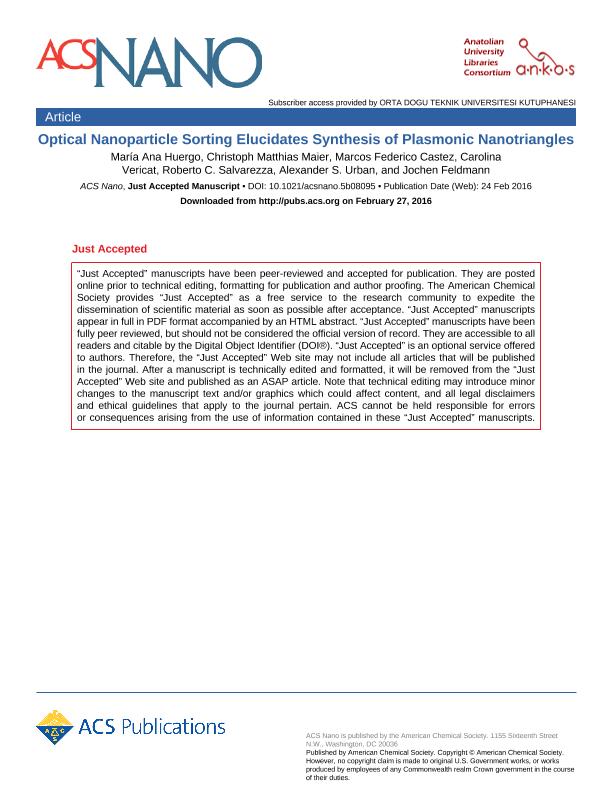Artículo
Optical nanoparticle sorting elucidates synthesis of plasmonic nanotriangles
Huergo, María Ana Cristina ; Maier, Christoph; Castez, Marcos Federico
; Maier, Christoph; Castez, Marcos Federico ; Vericat, Carolina
; Vericat, Carolina ; Nedev, Spas; Salvarezza, Roberto Carlos
; Nedev, Spas; Salvarezza, Roberto Carlos ; Urban, Alexander; Feldmann, Jochen
; Urban, Alexander; Feldmann, Jochen
 ; Maier, Christoph; Castez, Marcos Federico
; Maier, Christoph; Castez, Marcos Federico ; Vericat, Carolina
; Vericat, Carolina ; Nedev, Spas; Salvarezza, Roberto Carlos
; Nedev, Spas; Salvarezza, Roberto Carlos ; Urban, Alexander; Feldmann, Jochen
; Urban, Alexander; Feldmann, Jochen
Fecha de publicación:
02/2016
Editorial:
American Chemical Society
Revista:
ACS Nano
ISSN:
1936-0851
Idioma:
Inglés
Tipo de recurso:
Artículo publicado
Clasificación temática:
Resumen
We investigate the optical and morphological properties of gold nanoparticles grown by reducing a gold salt with Na2S. Lasers are tuned to the observed plasmon resonances, and the optical forces exerted on the nanoparticles are used to selectively print individual nanoparticles onto a substrate. This enables us to combine dark-field spectroscopy and scanning electron microscopy to compare the optical properties of single nanoparticles with their morphology. By arresting the synthesis at different times, we are able to investigate which type of nanoparticle is responsible for the respective resonances. We find that thin Au nanotriangles are the source of the observed near infrared (NIR) resonance. The initial lateral growth of these triangles causes the plasmon resonance to redshift into the NIR, whereas a subsequent thickening of the triangles and a concomitant truncation lead to a blueshift of the resonance. Furthermore, we find that the nanotriangles produced have extremely narrow line widths (187 ± 23 meV), show nearly isotropic scattering, and are stable for long periods of time. This shows their vast potential for applications such as in vivo imaging and bio(chemical) sensing. The method used here is generally applicable to other syntheses, and shows how complex nanostructures can be built up on substrates by selectively printing NPs of varying plasmonic resonances.
Archivos asociados
Licencia
Identificadores
Colecciones
Articulos(INIFTA)
Articulos de INST.DE INV.FISICOQUIMICAS TEORICAS Y APLIC.
Articulos de INST.DE INV.FISICOQUIMICAS TEORICAS Y APLIC.
Articulos(SEDE CENTRAL)
Articulos de SEDE CENTRAL
Articulos de SEDE CENTRAL
Citación
Huergo, María Ana Cristina; Maier, Christoph; Castez, Marcos Federico; Vericat, Carolina; Nedev, Spas; et al.; Optical nanoparticle sorting elucidates synthesis of plasmonic nanotriangles; American Chemical Society; ACS Nano; 10; 3; 2-2016; 3614-3621
Compartir
Altmétricas



